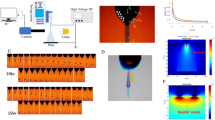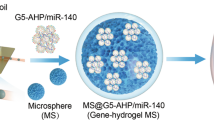Abstract
We examined nonviral, lipid-mediated gene transfer methods as potential tools for efficient transfection of articular chondrocytes. Transfection conditions were determined for primary cultures of normal human articular, osteoarthritic human articular and normal bovine articular chondrocytes using a lacZ reporter gene construct with the commercially available cationic liposomes Cellfectin, DMRIE-C, LipofectAmine, Lipofectin, LipoTaxi, TransFast and the lipid-based reagent FuGENE 6. Optimized conditions were then evaluated in an ex vivo model of chondrocyte transplantation. FuGENE 6 transfection produced the maximum levels of transgene expression. Transfection efficiency was cell type specific and affected by DNA concentration, lipid/DNA ratio and the presence of hyaluronidase, a matrix-degrading enzyme. Analysis of X-gal staining demonstrated an efficiency of 41.0% in normal bovine articular chondrocytes, 20.7% in normal human articular chondrocytes and 7.8% in osteoarthritic human chondrocytes. Transfected chondrocytes were found to successfully populate the articular cartilage surface in explant cultures. Transplanted genetically modified chondrocytes adhered to the articular cartilage and continued to produce β-galactosidase for 2 weeks. This evaluation and optimization of lipid-based gene transfer into articular chondrocytes may serve as a useful tool in studies of genes involved in articular cartilage damage and repair and as a potential delivery method for therapeutic genes.
This is a preview of subscription content, access via your institution
Access options
Subscribe to this journal
Receive 12 print issues and online access
$259.00 per year
only $21.58 per issue
Buy this article
- Purchase on Springer Link
- Instant access to full article PDF
Prices may be subject to local taxes which are calculated during checkout



Similar content being viewed by others
References
Buckwalter JA, Mankin HJ . Articular cartilage repair and transplantation Arthritis Rheum 1998 41: 1331–1342
Salter RB . The biologic concept of continuous passive motion of synovial joints. The first 18 years of basic research and its clinical application Clin Orthop 1989 242: 12–25
O'Driscoll SW, Salter RB . The induction of neochondrogenesis in free intra-articular periosteal autografts under the influence of continuous passive motion. An experimental investigation in the rabbit J Bone Joint Surg (Am) 1984 66: 1248–1257
Czitrom AA, Langer F, McKee N, Gross AE . Bone and cartilage allotransplantation. A review of 14 years of research and clinical studies Clin Orthop 1986 208: 141–145
Insall JN . Intra-articular surgery for degenerative arthritis of the knee J Bone Joint Surg (Br) 1967 49B: 211–228
Brittberg M et al. Treatment of deep cartilage defects in the knee with autologous chondrocyte transplantation New Engl J Med 1994 331: 889–895
Mankin HJ, Buckwalter JA . Restoration of the osteoarthrotic joint J Bone Joint Surg (Am) 1996 78: 1–2
Roessler BJ et al. Adenoviral-mediated gene transfer to rabbit synovium in vivo J Clin Invest 1993 92: 1085–1092
Yovandich J, O'Malley B, Sikes M, Ledley FD . Gene transfer to synovial cells by intra-articular administration of plasmid DNA Hum Gene Ther 1995 6: 603–610
Ghivizzani SC et al. Direct retrovirus-mediated gene transfer to the synovium of the rabbit knee: implications for arthritis gene therapy Gene Therapy 1997 4: 977–982
Ghivizzani SC et al. Direct adenovirus-mediated gene transfer of interleukin 1 and tumor necrosis factor alpha soluble receptors to rabbit knees with experimental arthritis has local and distal anti-arthritic effects Proc Natl Acad Sci USA 1998 95: 4613–4618
Trippel SB . Growth factors as therapeutic agents Instr Course Lect 1997 46: 473–476
Ikeda T et al. Adenovirus mediated gene delivery to the joints of guinea pigs J Rheumatol 1998 25: 1666–1673
Baragi VM et al. Transplantation of transduced chondrocytes protects articular cartilage from interleukin 1-induced extracellular matrix degradation J Clin Invest 1995 96: 2454–2460
Kang R et al. Ex vivo gene transfer to chondrocytes in full-thickness articular cartilage defects: a feasibility study Osteoarthr Cart 1997 5: 139–143
Baragi VM et al. Transplantation of adenovirally transduced allogeneic chondrocytes into articular cartilage defects in vivo Osteoarthr Cart 1997 5: 275–282
Doherty PJ et al. Resurfacing of articular cartilage explants with genetically-modified human chondrocytes in vitro Osteoarthr Cart 1998 6: 153–159
Ledley FD . Nonviral gene therapy: the promise of genes as pharmaceutical products Hum Gene Ther 1995 6: 1129–1144
Felgner PL et al. Lipofection: a highly efficient, lipid-mediated DNA-transfection procedure Proc Natl Acad Sci USA 1987 84: 7413–7417
Caplen NJ et al. Liposome-mediated CFTR gene transfer to the nasal epithelium of patients with cystic fibrosis Nature Med 1995 1: 39–46
Gao X, Huang L . Cationic liposome-mediated gene transfer Gene Therapy 1995 2: 710–722
Caplen NJ et al. In vitro liposome-mediated DNA transfection of epithelial cell lines using the cationic liposome DC-Chol/DOPE Gene Therapy 1995 2: 603–613
Nabel GJ et al. Direct gene transfer with DNA–liposome complexes in melanoma: expression, biologic activity, and lack of toxicity in humans Proc Natl Acad Sci USA 1993 90: 11307–11311
Lu Valle P et al. Multiple negative elements in a gene that codes for an extracellular matrix protein, collagen X, restrict expression to hypertrophic chondrocytes J Cell Biol 1993 121: 1173–1179
Long F, Linsenmayer TF . Tissue-specific regulation of the type X collagen gene. Analyses by in vivo footprinting and transfection with a proximal promoter region J Biol Chem 1995 270: 31310–31314
Pallante KM et al. The chick alpha2(I) collagen gene contains two functional promoters, and its expression in chondrocytes is regulated at both transcriptional and post-transcriptional levels J Biol Chem 1996 271: 25233–25239
Goldring MB et al. Interleukin-1 beta-modulated gene expression in immortalized human chondrocytes J Clin Invest 1994 94: 2307–2316
Viengchareun S et al. The transfection of rabbit articular chondrocytes is independent of their differentiation state In Vitro Cell Dev Biol Anim 1997 33: 15–17
Abe A, Miyanohara A, Friedmann T . Polybrene increases the efficiency of gene transfer by lipofection Gene Therapy 1998 5: 708–711
Nabel EG et al. Recombinant fibroblast growth factor-1 promotes intimal hyperplasia and angiogenesis in arteries in vivo Nature 1993 362: 844–846
Nabel EG et al. Recombinant platelet-derived growth factor B gene expression in porcine arteries induce intimal hyperplasia in vivo J Clin Invest 1993 91: 1822–1829
Eastman SJ et al. Biophysical characterization of cationic lipid: DNA complexes Biochim Biophys Acta 1997 1325: 41–62
Takeshita S et al. Increased gene expression after liposome-mediated arterial gene transfer associated with intimal smooth muscle cell proliferation. In vitro and in vivo findings in a rabbit model of vascular injury J Clin Invest 1994 93: 652–661
Mortimer I et al. Cationic lipid-mediated transfection of cells in culture requires mitotic activity Gene Therapy 1999 6: 403–411
Coonrod A, Li FQ, Horwitz M . On the mechanism of DNA transfection: efficient gene transfer without viruses Gene Therapy 1997 4: 1313–1321
Bonassar LJ, Trippel SB . Interaction of epidermal growth factor and insulin-like growth factor-I in the regulation of growth plate chondrocytes Exp Cell Res 1997 234: 1–6
Cotten M et al. Lipopolysaccharide is a frequent contaminant of plasmid DNA preparations and can be toxic to primary human cells in the presence of adenovirus Gene Therapy 1994 1: 239–246
Chen AC et al. Chondrocyte transplantation to articular cartilage explants in vitro J Orthop Res 1997 15: 791–802
Hunziker EB, Rosenberg LC . Repair of partial-thickness defects in articular cartilage: cell recruitment from the synovial membrane J Bone Joint Surg (Am) 1996 78: 721–733
Acknowledgements
We thank T Fondren, H Mankin and D Burke for human articular cartilage specimens, C Trahan for histological processing, L Weissbach and M Cucchiarini for helpful discussions. This work was supported by the German Academy for Natural Scientists LEOPOLDINA and NIH grants AR31068 and AR45749-01.
Author information
Authors and Affiliations
Rights and permissions
About this article
Cite this article
Madry, H., Trippel, S. Efficient lipid-mediated gene transfer to articular chondrocytes. Gene Ther 7, 286–291 (2000). https://doi.org/10.1038/sj.gt.3301086
Received:
Accepted:
Published:
Issue Date:
DOI: https://doi.org/10.1038/sj.gt.3301086
Keywords
This article is cited by
-
Potential therapeutic strategies for osteoarthritis via CRISPR/Cas9 mediated gene editing
Reviews in Endocrine and Metabolic Disorders (2024)
-
Biomaterial-guided delivery of gene vectors for targeted articular cartilage repair
Nature Reviews Rheumatology (2019)
-
Matrix Production in Chondrocytes Transfected with Sex Determining Region Y-Box 9 and Telomerase Reverse Transcriptase Genes: An In Vitro Evaluation from Monolayer Culture to Three-Dimensional Culture
Tissue Engineering and Regenerative Medicine (2019)
-
Cationic β-Cyclodextrin–Chitosan Conjugates as Potential Carrier for pmCherry-C1 Gene Delivery
Molecular Biotechnology (2016)
-
Nonviral gene transfer to human meniscal cells. Part I: transfection analyses and cell transplantation to meniscus explants
International Orthopaedics (2014)



